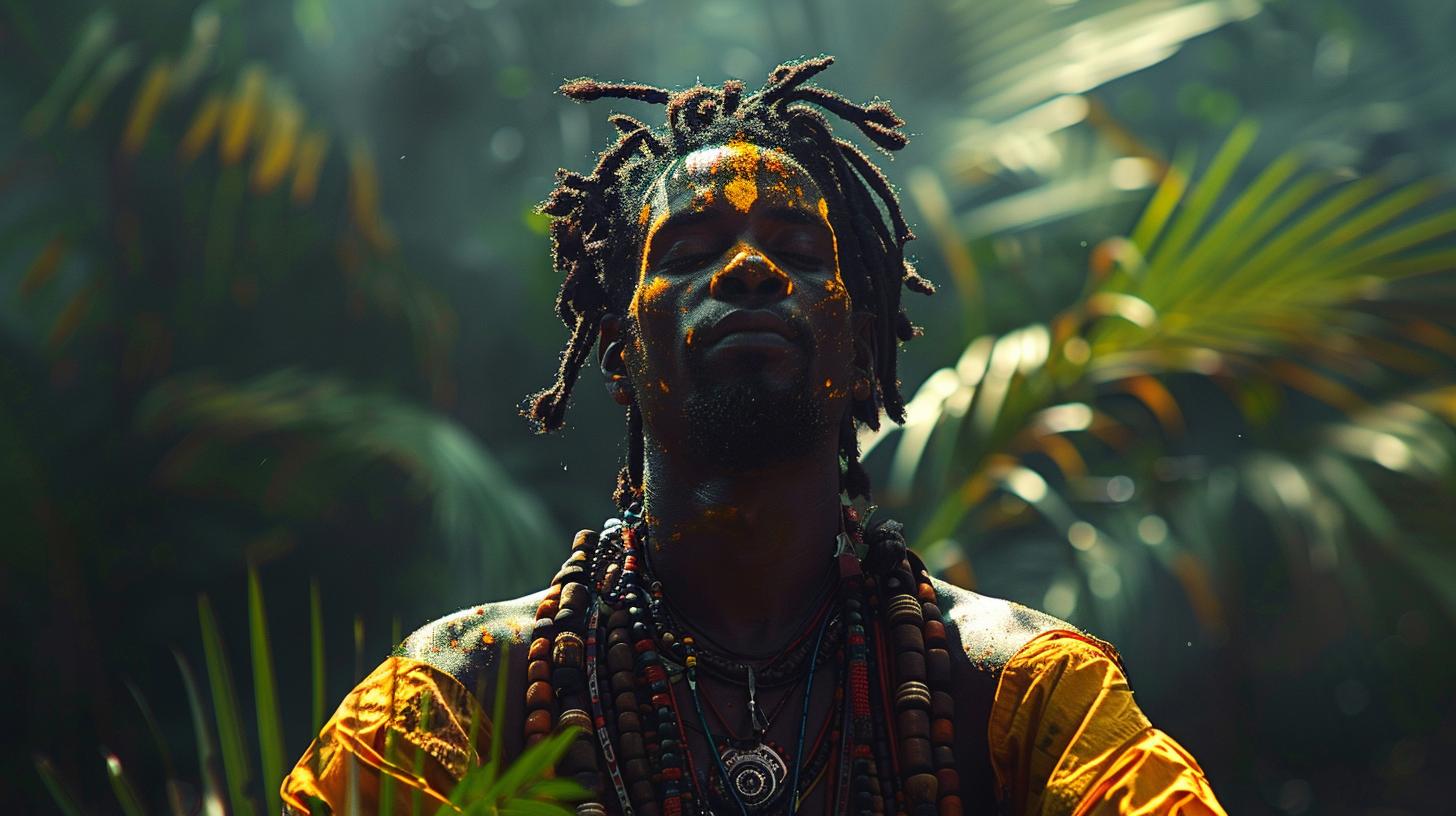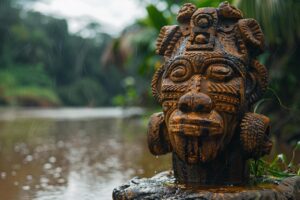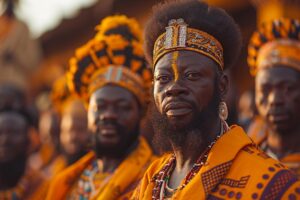Ashanti Mythology: Exploring the Spiritual Traditions of the Ashanti People

The Ashanti people, part of the Akan ethnic group from Ghana, have a rich mythology. Nyame is the supreme sky god, while Anansi is a clever spider god. Asase Yaa, the earth goddess, plays a vital role in Ashanti culture through rituals and ceremonies.
The mythology shapes daily life, art, and popular culture, reflecting a deep spiritual heritage.
Ashanti Mythology: The Origins of the Ashanti People
The Ashanti people’s mythology is deeply rooted in their origins as part of the Akan ethnic group from the Ashanti Region of modern-day Ghana.
The Akan Ethnic Group
- The Akan ethnic group is native to Ghana, with the Ashanti people being one of its prominent subgroups.
- They have a rich cultural heritage that includes colorful traditions, vibrant art forms, and intricate mythology.
The Ashanti Region of Ghana
- The Ashanti Region is located in southern Ghana and is considered the heartland of the Ashanti people.
- It is known for its lush landscapes, historic sites, and strong sense of cultural identity.
Nyame: The Supreme Sky God of Ashanti Mythology
Nyame, the supreme sky god in Ashanti mythology, holds a crucial role as the creator of the universe.
Revered by the Ashanti people, Nyame is worshipped and offered prayers for guidance and protection.
Nyame’s Role as Creator
Nyame is believed to have fashioned the world and all living beings, establishing order and balance in the cosmos. As the supreme deity, Nyame’s power and wisdom are reflected in the harmony of the natural world.
Attributes of Nyame:
- Creator of the universe
- Provider of guidance and protection
- Symbol of divine power and wisdom
Worship and Practices Honoring Nyame
The Ashanti people pay homage to Nyame through rituals and ceremonies that demonstrate their reverence and gratitude. Offerings and prayers are made to Nyame to seek blessings, wisdom, and divine favor.
Honoring Nyame:
- Rituals of worship and praise
- Sacrifices and offerings as signs of respect
- Prayers for guidance, protection, and prosperity
Anansi: The Clever Spider God
Anansi is a central figure in Ashanti mythology, embodying both wisdom and trickery. Through his cunning adventures, he teaches valuable lessons to the people.
Anansi’s Wisdom and Trickery
- Anansi is known for his cleverness and quick thinking.
- His ability to outsmart others often leads to unexpected outcomes.
- Despite his mischief, Anansi’s actions are guided by a deeper wisdom.
Teaching through Cunning Adventures
- Through his adventures, Anansi imparts important morals and values.
- His stories serve as cautionary tales and lessons for the Ashanti people.
- Anansi’s cunning acts challenge individuals to think critically and creatively.
Asase Yaa: The Earth Goddess
Asase Yaa, the earth goddess in Ashanti mythology, holds great importance in the cultural beliefs of the Ashanti people.
She is revered as the nurturer and sustainer of life, providing the fertile soil that allows crops to flourish and communities to thrive.
Asase Yaa’s Importance in Ashanti Culture
- Asase Yaa symbolizes fertility and abundance in the Ashanti culture.
- She is seen as the one who provides the nourishment necessary for sustenance and growth.
- The earth goddess is respected and honored for her role in maintaining the balance of nature.
Rituals and Ceremonies Honoring Asase Yaa
Rituals and ceremonies are conducted by the Ashanti people to pay homage to Asase Yaa and express gratitude for her blessings.
These ceremonies are a way to acknowledge the earth goddess’s role in the prosperity of the community and to seek her continued favor.
- During ceremonies, offerings of food and libations are made to Asase Yaa.
- Prayers are offered to seek her protection and guidance in agrarian activities.
- Community members come together to celebrate Asase Yaa’s abundance and seek her blessings for a fruitful harvest.
Ashanti Mythology in Daily Life
Discover how Ashanti mythology influences the daily lives of the Ashanti people through traditions, festivals, and cultural practices.
Adae Festivals and Ancestral Spirits
- Celebrating the spirits of ancestors during the vibrant Adae festivals
- Honoring the connection between the spiritual and earthly realms
- Rituals and ceremonies paying homage to the ancestral spirits
The Significance of Kente Cloth
- Exploring the deep spiritual meaning behind the intricate patterns of Kente cloth
- Symbolizing the cultural heritage and divine connections of the Ashanti people
- How Kente cloth is woven into daily life, ceremonies, and special occasions
Artistic Expressions in Ashanti Mythology
The artistic expressions of the Ashanti people are deeply intertwined with their mythological beliefs and cultural heritage.
Through rhythmic dances and symbolic art, the Ashanti community honors their divine ancestry and connects to the spiritual realm.
Rhythmic Dances and Symbolic Art
- Rhythmic dances play a significant role in Ashanti mythology, serving as a form of worship and storytelling. These dances are not just entertainment but a way to communicate with the gods and ancestors.
- Symbolic art, such as intricate carvings and beadwork, often depict scenes from Ashanti mythology, showcasing the rich tapestry of stories that have been passed down through generations.
- The vibrant colors and patterns in Ashanti art convey deeper meanings, representing concepts like unity, strength, and spirituality within the community.
Connecting to Divine Heritage
- Artistic expressions in Ashanti culture serve as a bridge between the earthly and spiritual realms, allowing individuals to connect with their divine heritage and ancestral traditions.
- By participating in artistic practices, such as creating traditional textiles or performing sacred dances, the Ashanti people affirm their cultural identity and maintain a strong connection to their mythological beliefs.
- Through these creative outlets, the Ashanti community continues to celebrate their heritage and pass down their rich traditions to future generations, ensuring the preservation of their cultural legacy for years to come.
Influence of Ashanti Mythology in Popular Culture
Ashanti mythology has left a significant impact on popular culture, inspiring writers, artists, and filmmakers to explore its rich tapestry of stories and characters.
Through their creative works, these individuals have brought the mystical world of Ashanti mythology to life for audiences around the globe.
Inspiration for Writers, Artists, and Filmmakers
Ashanti mythology serves as a wellspring of inspiration for creatives in various fields. Writers draw upon the intricate narratives and characters to craft compelling stories that captivate readers. Artists incorporate the symbolism and imagery of Ashanti deities into their visual creations, adding depth and meaning to their artwork.
Exploring the Rich Tapestry of Stories
The stories within Ashanti mythology offer a treasure trove of themes and motifs waiting to be explored. Filmmakers adapt these tales into visually stunning productions that transport audiences into the mystical realm of the Ashanti pantheon.
Through film, viewers can immerse themselves in the vivid landscapes and colorful characters that populate Ashanti mythology.
Continuing Traditions in Ashanti Mythology
Exploring the enduring customs and practices within Ashanti mythology highlights the community’s commitment to honoring their rich heritage.
Celebrating Heritage and Passing Down Traditions
- Annual ceremonies and festive gatherings bring the community together to commemorate their cultural legacy.
- Elderly members of the community play a crucial role in transmitting oral histories and traditional practices to younger generations.
- The passing down of symbolic artifacts and stories ensures that the essence of Ashanti mythology remains alive and relevant.
Sustaining Spiritual Beliefs for Future Generations
- Educational initiatives and community programs focus on instilling spiritual values and beliefs in the youth.
- Rituals and prayers dedicated to ancestral spirits serve as a means of connecting present generations with their past.
- The continued integration of Ashanti mythology in various aspects of daily life reinforces the importance of spiritual sustenance for the community’s future prosperity.
.




















